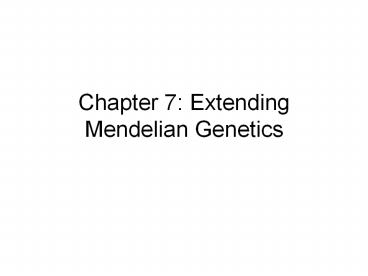Chapter 7: Extending Mendelian Genetics - PowerPoint PPT Presentation
1 / 18
Title:
Chapter 7: Extending Mendelian Genetics
Description:
Chapter 7: Extending Mendelian Genetics Section 1: Chromosomes & Phenotype Autosomal Genes & Phenotype Phenotype is determined by 2 copies of each autosomal gene ... – PowerPoint PPT presentation
Number of Views:411
Avg rating:3.0/5.0
Title: Chapter 7: Extending Mendelian Genetics
1
Chapter 7 Extending Mendelian Genetics
2
Section 1 Chromosomes Phenotype
3
Autosomal Genes Phenotype
- Phenotype is determined by 2 copies of each
autosomal gene - Mendel studied autosomal characteristics
- Most traits in humans are determined by autosomal
genes
4
Autosomal Disorders
- Many genetic disorders are caused by recessive
alleles on autosomes - NN healthy
- Nn healthy carrier for the disorder
- nn has disorder
- Less genetic disorders are caused by dominant
alleles on autosomes - NN and Nn has disorder
- nn healthy
5
Sex-Linked Traits
- Genes located on the sex chromosomes (X or Y) are
called sex-linked genes - Genes on the Y chromosome are responsible for
male characteristics only - X chromosome has many more genes that affect many
traits - In males, all sex-linked traits are expressed
- they only have one copy of each chromosome, so
all alleles are expressed even if theyre
recessive
6
X Chromosome Inactivation
- Since females have 2 X chromosomes, one of them
is randomly turned off in each cell - Because it is random, a female will have some
cells with one X turned off, and others with the
other X turned off
7
Section 2 Complex Patterns of Heredity
8
Complex Patterns
- Incomplete dominance - heterozygous individual
shows a blending of the two homozygous phenotypes - Ex. Four oclock plants
- RR red flowers
- rr white flowers
- Rr pink flowers
9
- Codominance - both alleles are dominant, so both
are fully and separately expressed - Ex. Human ABO blood type - has multiple alleles
(IA, IB, i) - IAIA or IAi type A blood
- IBIB or IBi type B blood
- IAIB type AB blood
- ii type O blood
10
- Polygenic traits - traits produced by two or more
genes, leading to a range of phenotypes - Ex. human skin tone, human eye color
- In a polygenic trait, one gene may be epistatic,
meaning it can interfere with the expression of
the other genes - Ex. albinism in mammals
11
Genes the Environment
- Phenotype is usually a mixture of genes the
environment - Ex. genes determine your underlying skin tone
hair color, but sunlight can cause your skin to
become darker and hair to become lighter
12
Section 4 Human Genetics Pedigrees
13
Human Genetics
- Humans follow the same basic patterns of heredity
- The inheritance of many human traits can be very
complex - Polygenic traits, the environment, etc
- Some human traits are single-gene traits that
follow simple dominant and recessive patterns
like Mendels peas - Ex. widows peak, Huntingtons disease
14
X and Y Chromosomes
- X chromosome is 3x larger than the Y has many
more genes - Since females have 2 X chromosomes, they can be
carriers for sex-linked traits - Sex-linked disorders are more common in males
since they only have one X chromosome
15
Pedigree
- Circle female
- Square male
- Shaded person with trait
- Unshaded person without trait
- Half shaded carrier for a genetic disorder
- Horizontal line marriage
- Vertical line bracket offspring
- For some individuals in a pedigree, you can
determine genotypes based on their phenotypes
16
Pedigrees Tracing Autosomal Traits
- If trait is recessive, shaded individuals would
be nn, unshaded would be NN or Nn, carriers would
be Nn - If trait is dominant, unshaded would be nn,
shaded would be either NN or Nn
17
Pedigrees for sex-linked traits
- Shaded females must be homozygous recessive XnXn
- Unshaded females could be XNXN or XNXn - carrier
- Shaded males must have the recessive allele XnY
- Unshaded males must have the dominant allele XNY
18
Karyotype
- Picture of all the chromosomes in a cell (see pg.
217) - Can show gender as well as any chromosomal
abnormalities - Down syndrome extra chromosome 21
- Turners syndrome female only has 1 X
- Klinefelters syndrome male has XXY
- Caused by non-disjunction, which is when
chromosomes fail to separate during meiosis































